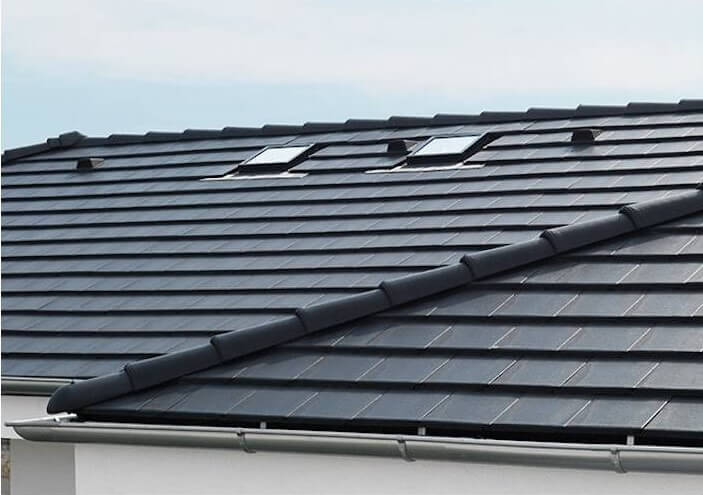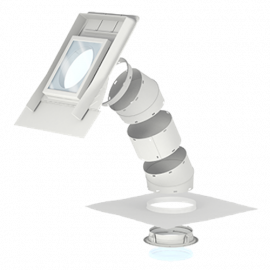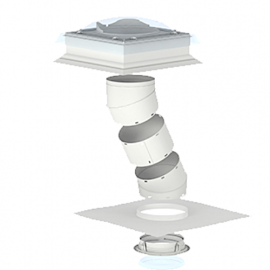There are many ways to bring more light into your home – get rid of any curtains or other objects that stand in the way of daylight getting inside, replace your windows with bigger ones or, in case of loft conversion projects, install roof windows to turn your old, dark attic into a beautiful living space. But what happens when none of these options is available? Is this the end of your dreams of having a well-lit home filled with sunshine?
Of course not, you can use light tubes for houses to brighten dark corners and rooms that don’t usually get a lot of sunlight. Using a roof light tunnel is a cost-effective solution that can help you completely transform your home by providing daylight and making it more comfortable. In the article below, we’ll take a closer look at this product to explain its advantages and disadvantages and help you decide whether it’s a good addition to your home.
Table of Contents
What is a sun tunnel? How does it work?
A sun tunnel is a rather simple structure that can be used to transmit daylight into the inner parts of your home – it’s especially useful in rooms where access to sunlight is limited due to lack of windows or their low daylight exposure and in rooms where you want to enjoy natural light, but you’re worried that installing windows will affect your comfort and privacy, e.g., in bathrooms.
To give the simplest definition the sun tunnel is a round hole in your roof, covered with a glass pane, that captures the sun’s rays that fall onto the surface and sends them down the reflective tube into space below where the light reaches the diffuser and provides illumination to your room.
But it’s also important to note that while they can be used instead of skylights when it comes to providing natural lighting, they cannot provide fresh air – their sealed construction offers great insulation and reduced heat gain during the summer and heat loss in the winter, but you’ll need to find another source of ventilation for your room.
Are sun tunnels difficult to install?
Sun tunnels are quick and easy to install – to ensure their optimal performance we advise hiring a contractor to do the job, though if you want to attempt a DIY installation make sure you have someone to help you for safety reasons and read the instructions carefully before getting to work. The installation process doesn’t require making any structural changes to the roof – in order to install a sun-pipe you need to:
- cut out holes in your roof and ceiling
- install a sun tunnel dome with the right flashing on the roof
- install a ceiling fixture with a diffuser in the ceiling
- add a tube to connect the dome with the diffuser.
Flat roofs vs. pitched roofs – where can you install sun tunnels?
This solution comes in two types – sun tunnels for pitched roofs and sun tunnels for flat roofs. This means that no matter what type of roof you have, you can use a light tunnel to brighten your rooms. But apart from choosing the right type for your roof, pay attention to the sizes as well. Different models can vary in length, so make sure to choose one that can fit into the available space between your roof and ceiling. Available as both rigid and flexible tubes they can be installed around obstacles and in difficult-to-install locations.
Where is the best place to install a sun tunnel?
When choosing the perfect location for your sun tunnel on the roof, make sure to choose the area that already gets a lot of sunlight and isn’t shaded throughout the day. This will enable you to get as much natural lighting into your home as possible.
How many do you need?
While sun tunnels cannot offer you the same amount of sunlight a skylight can, in a dark and gloomy room adding even a single light tube can completely transform the way it looks by increasing its comfort and functionality. Similarly as with roof windows – the more light you want, the more of them you need to install. So, if possible, try adding more than one or choose a bigger model.
Now that you know more about them, you can already see why they are becoming more and more popular among homeowners. But their ability to bring light to previously dark and unpleasant spaces results not only in an increased level of comfort but also in lower energy bills – they limit the need for artificial lighting throughout the day effectively reducing your spendings.
Other products in category: Sun Tunnels
£400.00 tax excl.
Other products in category: Sun Tunnels
£450.00 tax excl.
People Also Ask:
Do sun tunnels provide heat?
Unlike roof windows, sun tubes don’t provide direct sunlight – when light reaches your roof, it enters the tunnel through the dome, then goes through the entire length of the tunnel to finally be diffused into the room below. This means that while overheating is a common issue with skylights, installing a sun tube will not cause similar problems.
Do sun tunnels leak?
When you get a high-quality sun tunnel and install it correctly, the risk of leakages is very low because their sealed construction and their shape that stops water from building up on the surface are very effective when it comes to preventing leaks.
How do you clean a sun tunnel?
You can clean the glass panes with a soap and water solution – there’s no need to clean the inside of the tube. You can remove the diffuser in order to clean it, but make sure to follow the instructions carefully when you do it.

